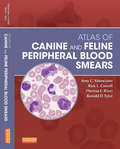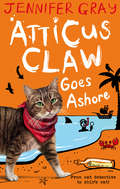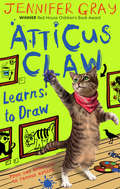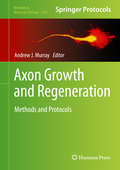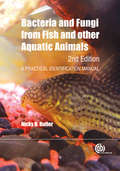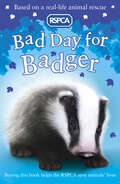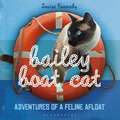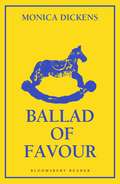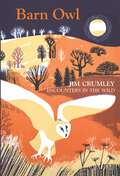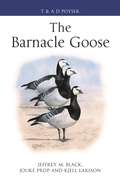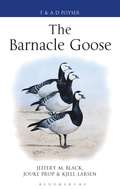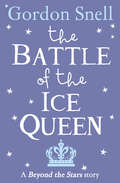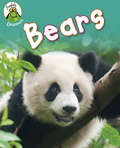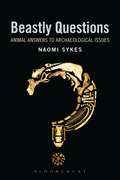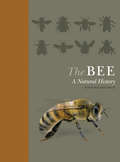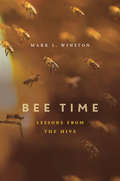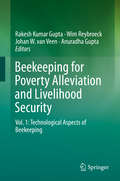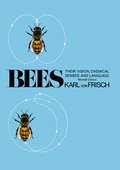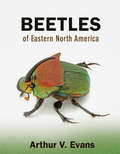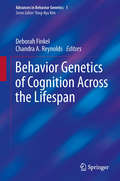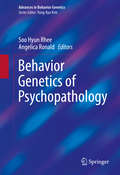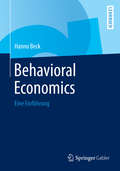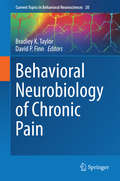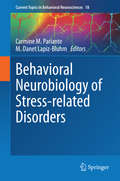- Table View
- List View
Atlas of Canine and Feline Peripheral Blood Smears - E-Book: Atlas Of Canine And Feline Peripheral Blood Smears (Small Animal Laboratory Essentials)
by Ms, Dacvp, Rick L. Cowell, Dvm, Ms, Mrcvs, Dacvp Dvm, Ms, Dacvp, Rick L. Cowell, DvmAn illustrated guide to the morphology of blood cells, Atlas of Canine and Feline Peripheral Blood Smears covers patient assessment for common hematologic disorders and diseases in dogs and cats. Over 1,000 full-color photomicrographs depict abnormalities within each blood cell line, with multiple pictures of each morphologic abnormality and variations in their appearance. Written by pathology experts Amy Valenciano, Rick Cowell, Theresa Rizzi, and Ronald Tyler, this concise reference will enhance your skills as you interpret blood smears and recognize hematological cellular response to inflammation, infection, and toxicity. "Everything you might encounter looking at dog or cat blood smears is right there, clearly classified and noted (more than 1000 pictures!). Pitfalls and artefacts are clearly explained. The format (spiral binding) makes it the obvious accessory for your microscope. A good investment." Reviewed by: Vet's Today Date: July 2014Over 1,000 photomicrographs facilitate microscopic analysis and interpretation of the cellular components of the blood.Full-color, high-resolution images facilitate identification of different blood cell types, numbers, anomalies and conditions.Multiple representations of morphologic abnormalities aid in recognition of conditions where variations in appearance commonly occur.Practical information includes an overview of laboratory methods, equipment and supplies, sample collection, staining and handling, and diagnostic interpretation of blood smears.Coverage of 125 topics ranges from the morphology of erythrocytes to chronic myeloid leukemia. Spiral binding allows the book to lay open next to the microscope, making it a quick and easy reference while on the job.
Atticus Claw Goes Ashore (Atticus Claw: World's Greatest Cat Detective #4)
by Jennifer GrayAtticus is on beach tidying duty with the kittens when he finds a message in a bottle from Fishhook Frank. Fishhook is marooned on a desert island, but he promises Atticus treasure in exchange for his rescue! The treasure in question is the Casket of Desires, which contains a sleeping mermaid who has the power to grant any wish. But it is hidden in the deepest darkest part of the ocean, protected by the most hideous, fearsome sea-creatures known to pirate lore. Atticus sets out to rescue Fishhook Frank and find the Casket of Desires with his owners, the Cheddar family. But it's not all plain sailing. The pirate with the biggest beard-jumper in the nautical world - Captain Black Beard-Jumper - is also on the look out for the Casket and he'll curse anyone who gets in his way...
Atticus Claw Learns to Draw (Atticus Claw: World's Greatest Cat Detective #5)
by Jennifer GrayAtticus Claw Leans to Draw by Jennifer Gray is the latest in this popular series about master-criminal turned police-cat, Atticus Claw.Famous works of art are going missing. Atticus is on the case. The prime suspect is Ricardo Butteredsconi - Italian theme park entrepreneur and art connoisseur. Then Inspector Cheddar goes missing from the Tate Modern, and Atticus and his friends suspect Butteredsconi and his evil pet pig. In the scariest adventure of his nine lives, Atticus has to act fast if he wants to stop Inspector Cheddar becoming a waxwork!'Should be a hit for anyone who is, or has been, ten years old.' The Bookbag'Worth it for the delightfully feline puns alone.' Herald'As many ups and downs, triumphs and disasters, thrills and spills as ever.' Carousel'Atticus Claw is a masterpiece!' Sam, age 12'Very funny and interesting.' Aram age 9'Atticus is naughty and really cool!' Lucas, age 7'Atticus Claw is fantastic.' Charlotte, age 8
Axon Growth and Regeneration: Methods and Protocols (Methods in Molecular Biology #1162)
by Andrew J. MurrayAxon Growth and Regeneration: Methods and Protocols brings together a diverse set of techniques for the study of the mechanisms underlying central nervous system axon growth, consequently providing a resource that will aid in the development of repair strategies. After an introductory section, this detailed volume continues with sections focusing on axon growth in vitro, providing a range of protocols that can be used to examine intracellular signalling pathways, axonal responses to extracellular factors and methods for quantifying outgrowth. The next section provides protocols for inducing experimental injury in vivo as well as some highly promising protocols for promoting regeneration, which segues into the final section highlighting a series of protocols that can be used to monitor the extent of axon regeneration in vivo, ranging from tract tracing to in vivo imaging and functional recovery. As a book in the Methods in Molecular Biology series, chapters contain introductions to their respective topics, lists of the necessary materials and reagents, step-by-step, readily reproducible laboratory protocols and tips on troubleshooting and avoiding known pitfalls.Practical and reliable, Axon Growth and Regeneration: Methods and Protocols aims to serve researchers studying axon regeneration with a significant set of diverse tools, vital for moving on to the next generation of exciting new discoveries in the field.
Bacteria and Fungi from Fish and Other Aquatic Animals: A Practical Identification Manual
by Nicky BullerThis practical book provides an updated resource for the identification of bacteria found in animals inhabiting the aquatic environment, illustrated with colour photos. It contains expanded biochemical identification tables to include newly identified pathogenic and saprophytic bacteria, molecular identification tests now available for a greater number of aquatic bacterial pathogens, more information on the pathogenesis and virulence of each organism and new coverage of traditional and molecular identification of fungal pathogens and quality assurance standards for laboratories.
Bad Day For Badger (Rspca Ser. #9)
by Sarah HawkinsWhen Lewis and his dad see an injured badger on the side of the road they call the RSPCA. But when the RSPCA arrive to examine the young badger,she scampers under a parked car, only to get well and truly stuck! The RSPCA must work with the Fire and Rescue team to try and free the baby badger, and Lewis is going to do all he can to help.
Bailey Boat Cat: Adventures Of A Feline Afloat
by Louise KennedyBailey is a boat cat. He loves nothing more than cruising aboard Nocturne, gazing wistfully out of portholes, lounging on the sun deck wearing his cat lifejacket, climbing the mast and generally fulfilling his important boat-cat duties – and blogging about them at baileyboatcat.com. This book captures Bailey's charm with lovable photos, pearls of 'whisker wisdom' and cheeky asides, all from a cat's eye view. Chatty, inquisitive and boasting an undeniable cute factor, Bailey explains (for the benefit of us slow-witted humans) the five steps of marine navigation, the importance of cubby holes, and just why cats are so much cleverer than dogs…Packed with fabulous photography throughout, this endearing gift book will go down a treat with sailors and cat lovers alike.
Ballad of Favour
by Monica DickensThe summer is over and Rose Wood leaves the Wood Briar Hotel for school. Rose misses the summer buzz and her freedom from school, and with several weeks passing by quietly since her magical adventure with the Great Gray Horse she worries that her mission as the messenger of this ancient, brave horse is over.But when the mysterious composer, Mr Vingo, returns to the hotel, Favour, the Great Gray Horse reappears and Rose is summoned for another mission. This time she travels to an abandoned house in a town nearby where a forlorn family tries to survive their hardships. Will Rose and the horse be able to help them? Will Rose resist the temptation to share her secret with her friends, Abigail and Ben? She can only stay the messenger of the horse if she is brave and works undiscovered… The Ballad of Favour, is the second book in the four-part fantasy adventures series about Rose and the magical Great Grey Horse.
Barn Owl: Encounters in the Wild (Encounters In The Wild Ser.)
by Jim Crumley"An utter delight" Jennifer Tetlow. Renowned nature writer Jim Crumley gets up close and personal with some of Britain’s most iconic and loved animals - here, the barn owl.? The Encounters in the Wild series not only offers insights into their extraordinary lives, but also considers the conservation efforts to protect them and how the future looks for these much loved animals.
The Barnacle Goose
by Jeffrey M. Black Jouke Prop Kjell LarssonThe Barnacle Goose, a distinctive, handsome black-and-white bird, gets its name from a mediaeval myth that the birds hatched from barnacles – how else to explain their sudden appearance each autumn in northern Britain? We now know, of course, that the birds migrate from Arctic Russia, Norway and Svalbard to winter throughout northern Europe. This book represents a culmination of more than 25 years of Barnacle Goose research. It represents the story of one of Europe's most celebrated long-term behavioral studies, detailing the lives of these social and sociable birds. Chapters include sections on pair formation and bonding, family and population dynamics, brood parasitism, food and feeding, size and shape in different populations, life cycle, survivorship, dispersal, migration, and conservation, with particular regard to climate change. It is a rigorous and thorough examination of the lives of these birds, in fine Poyser tradition.
The Barnacle Goose
by Jeffrey M. Black Jouke Prop Kjell LarssonThe Barnacle Goose, a distinctive, handsome black-and-white bird, gets its name from a mediaeval myth that the birds hatched from barnacles – how else to explain their sudden appearance each autumn in northern Britain? We now know, of course, that the birds migrate from Arctic Russia, Norway and Svalbard to winter throughout northern Europe. This book represents a culmination of more than 25 years of Barnacle Goose research. It represents the story of one of Europe's most celebrated long-term behavioral studies, detailing the lives of these social and sociable birds. Chapters include sections on pair formation and bonding, family and population dynamics, brood parasitism, food and feeding, size and shape in different populations, life cycle, survivorship, dispersal, migration, and conservation, with particular regard to climate change. It is a rigorous and thorough examination of the lives of these birds, in fine Poyser tradition.
The Battle of the Ice Queen: Beyond The Stars
by Gordon SnellAn atmospheric short story taken from the collection, BEYOND THE STARS, written and illustrated by two great Irish talents in children’s fiction today
Bears (Froglets: Learners #1)
by Annabelle LynchFind out all about bears and their cuddly cubs, from gentle pandas to fierce polar bears.Froglets Learners offer fun facts in accessible text, perfect for building reading confidence.
Beastly Questions: Animal Answers to Archaeological Issues
by Naomi SykesZooarchaeology, or the study of ancient animals, is a frequently side-lined subject in archaeology. This is bizarre given that the archaeological record is composed largely of debris from human–animal relationships (be they in the form of animal bones, individual artifacts or entire landscapes) and that many disciplines, including anthropology, sociology, and geography, recognise human–animal interactions as a key source of information for understanding cultural ideology. By integrating knowledge from archaeological remains with evidence from texts, iconography, social anthropology and cultural geography, Beastly Questions: Animal Answers to Archaeological Issues seeks to encourage archaeological students, researchers and those working in the commercial sector to offer more engaging interpretations of the evidence at their disposal. Going beyond the simple confines of 'what people ate', this accessible but in-depth study covers a variety of high-profile topics in European archaeology and provides novel interpretations of mainstream archaeological questions. This includes cultural responses to wild animals, the domestication of animals and its implications on human daily practice, experience and ideology, the transportation of species and the value of incorporating animals into landscape research, the importance of the study of foodways for understanding past societies and how animal studies can help us to comprehend issues of human identity and ideology: past, present and future.
The Bee: A Natural History
by Noah Wilson-Rich Kelly Allin Norman Carreck Andrea QuigleyGenericBees pollinate more than 130 fruit, vegetable, and seed crops that we rely on to survive. Bees are crucial to the reproduction and diversity of flowering plants, and the economic contributions of these irreplaceable insects measure in the tens of billions of dollars each year. Yet bees are dying at an alarming rate, threatening food supplies and ecosystems around the world. In this richly illustrated natural history of the bee, Noah Wilson-Rich and his team of bee experts provide a window into the vitally important role that bees play in the life of our planet.Earth is home to more than 20,000 bee species, from fluorescent-colored orchid bees and sweat bees to flower-nesting squash bees and leaf-cutter bees. This book takes an incomparable look at this astounding diversity, blending an engaging narrative with practical, hands-on discussions of such topics as beekeeping and bee health. It explores our relationship with the bee over evolutionary time, delving into how it came to be, where it stands today, and what the future holds for humanity and bees alike.Provides an accessible, illustrated look at the human–bee relationship over timeFeatures a section on beekeeping and handy go-to guides to the identification, prevention, and treatment of honey bee diseasesCovers bee evolution, ecology, genetics, and physiologyIncludes a directory of notable bee speciesPresents a holistic approach to bee health, including organic and integrated pest management techniquesShows what you can do to help bee populations
Bee Time: Lessons from the Hive
by Mark L. WinstonBeing among bees is a full-body experience, Mark Winston writes. Bee Time presents his reflections on three decades spent studying these remarkable creatures, and on the lessons they can teach about how humans might better interact with one another and the natural world, from the boardroom to urban design to agricultural ecosystems.
Bee Time: Lessons from the Hive
by Mark L. WinstonBeing among bees is a full-body experience, Mark Winston writes. Bee Time presents his reflections on three decades spent studying these remarkable creatures, and on the lessons they can teach about how humans might better interact with one another and the natural world, from the boardroom to urban design to agricultural ecosystems.
Beekeeping for Poverty Alleviation and Livelihood Security: Vol. 1: Technological Aspects of Beekeeping
by Rakesh Kumar Gupta Wim Reybroeck Johan W. Veen Anuradha GuptaThis Book intends to address all aspects needed to develop beekeeping into a powerful instrument of rural development and will focus on beekeeping as a tool for Poverty Alleviation and Livelihood security. In the backdrop of the social and economic issues of the people living in poverty region, the book aims to delineate specific motivation approaches to engage them in beekeeping and will serve as a guide for effective marketing through diversification and value addition of bee products. Nevertheless, marketing and environmental issues will remain an important component of this book. The aim is also to focus on indirect benefit of beekeeping so that it is integrated with farming and nature conservation. Other topics include ensuring the provision of practical techniques in handling and management of bees. It will provide detailed information on good contacts with policymakers and authorities; and channels for attracting finance especially in the third world countries. An interdisciplinary approach is the key feature of the book and it will also focus on few case histories and success stories to encourage the reader to take up beekeeping as a new venture gradually in a phased manner like traditional-transitional and modernised beekeeping. With the publication of this book, we hope to hand out a practical guide that will assist all those who are involved in beekeeping for development. We hope it will stimulate beekeeping as an integrated activity with farming and nature conservation and will serve in many households for poverty alleviation and livelihood security.
Bees: Their Vision, Chemical Senses, and Language
by Karl von FrischOver half a century of brilliant scientific detective work, the Nobel Prize-winning biologist Karl von Frisch learned how the world, looks, smells, and tastes to a bee. More significantly, he discovered their dance language and their ability to use the sun as a compass. Intended to serve as an accessible introduction to one of the most fascinating areas of biology, Bees (first published in 1950 and revised in 1971), reported the startling results of his ingenious and revolutionary experiments with honeybees. In his revisions, von Frisch updated his discussion about the phylogenetic origin of the language of bees and also demonstrated that their color sense is greater than had been thought previously. He also took into consideration the electrophysiological experiments and electromicroscopic observations that have supplied more information on how the bee analyzes polarized light to orient itself and how the olfactory organs on the bee's antennae function. Now back in print after more than two decades, this classic and still-accurate account of the behavior patterns and sensory capacities of the honeybee remains a book "written with a simplicity, directness, and charm which all who know him will recognize as characteristic of its author. Any intelligent reader, without scientific training, can enjoy it."—Yale Review
Beetles of Eastern North America (PDF)
by Arthur V. EvansBeetles of Eastern North America is a landmark book--the most comprehensive full-color guide to the remarkably diverse and beautiful beetles of the United States and Canada east of the Mississippi River. It is the first color-illustrated guide to cover 1,406 species in all 115 families that occur in the region--and the first new in-depth guide to the region in more than forty years. Lavishly illustrated with over 1,500 stunning color images by some of the best insect photographers in North America, the book features an engaging and authoritative text by noted beetle expert Arthur Evans.Extensive introductory sections provide essential information on beetle anatomy, reproduction, development, natural history, behavior, and conservation. Also included are tips on where and when to find beetles; how to photograph, collect, and rear beetles; and how to contribute to research. Each family and species account presents concise and easy-to-understand information on identification, natural history, collecting, and geographic range. Organized by family, the book also includes an illustrated key to the most common beetle families, with 31 drawings that aid identification, and features current information on distribution, biology, and taxonomy not found in other guides.An unmatched guide to the rich variety of eastern North American beetles, this is an essential book for amateur naturalists, nature photographers, insect enthusiasts, students, and professional entomologists and other biologists.Provides the only comprehensive, authoritative, and accessible full-color treatment of the region's beetlesCovers 1,406 species in all 115 families east of the Mississippi RiverFeatures more than 1,500 stunning color images from top photographersPresents concise information on identification, natural history, collecting, and geographic range for each species and familyIncludes an illustrated key to the most common beetle families
Behavior Genetics of Cognition Across the Lifespan (Advances in Behavior Genetics #1)
by Deborah Finkel Chandra A. ReynoldsAlong with psychopathology, cognition has been one of the primary phenotypic focal points of the field of behavior genetics since its inception. Francis Galton’s 1874 examination of eminent families in Britain was among the earliest attempts to investigate whether cognitive achievements run in families. This volume presents current methodologies for understanding cognitive abilities that move beyond the outdated nature vs. nurture paradigm. Recent advances in both collection and statistical modeling of twin data, particularly longitudinal twin data, make this an especially advantageous moment to produce a work that presents a collection of the groundbreaking research on cognitive abilities across the lifespan. This volume presents an overview of the current state of quantitative and molecular genetic investigations into the many facets of cognitive performance and functioning across the lifespan.
Behavior Genetics of Psychopathology (Advances in Behavior Genetics #2)
by Soo Hyun Rhee Angelica RonaldAs a dynamic, interdisciplinary field, behavior genetics and its evolution are being followed closely by scientists across the psychological and medical domains. The discoveries surrounding the human genome and the advancement in molecular genetic technologies have led to studies becoming increasingly sophisticated and yielding yet more conclusive and useful results. This is certainly the case in the area of child and adult psychopathology. Behavior Genetics of Psychopathology summarizes the state of the field, examiningthe role of genes and environment as they affect common neurodevelopmental and psychiatric conditions. Emphasizing key research areas (comorbidities, twin studies, the integration of methods), the book assesses the current literature, offers up-to-date findings, sorts through lingering controversies, and identifies a clear future agenda for the field. Expertly-written chapters focus on issues of both general salience that shape behavior genetics of psychopathology, to specific disorders of major clinical importance, among them: ADHD: the view from quantitative genetic research.Autism spectrum disorders and their complex heterogeneityGenetic influences on anxiety and depression in childhood and adolescence.Evidence for etiologically-defined subgroups within the construct of antisocial behavior.Sleep and psychopathology: the reasons for their co-occurrence. Behavioral genetic approaches to the etiology of comorbidity.Epigenetics of psychopathology. This combination of timeliness and depth of coverage make Behavior Genetics of Psychopathology a frontline resource for behavior geneticists, psychologists, psychiatrists, and neuroscientists, and is perfectly suited to graduate students looking to join these fields.
Behavioral Economics: Eine Einführung
by Hanno BeckSeit den siebziger Jahren haben die Erkenntnisse und Forschungen der Psychologie auch Einzug in die Wirtschaftswissenschaften gehalten – sie sollen das Menschenbild der Ökonomen und ihre Modelle realistischer machen. Dieses Buch beschreibt die wichtigsten Methoden, Konzepte und Erkenntnisse der verhaltenswissenschaftlichen Ökonomik (Behavioral Economics) und weitere dazugehörige Forschungsgebiete wie Glücksforschung, Fairness und Neuroökonomie. Das Lehrbuch stellt die wichtigsten theoretischen und empirischen Befunde und Ideen vor, um sie anschließend einer kritischen Würdigung zu unterziehen. Es ist sowohl für Studierende geeignet als auch für Dozenten und Wissenschaftler, die sich über den aktuellen Forschungsstand der Disziplin informieren wollen.
Behavioral Neurobiology of Chronic Pain (Current Topics in Behavioral Neurosciences #20)
by Bradley K. Taylor David P. FinnPain is the most common reason people seek medical help. The treatment of chronic pain is a major unmet clinical need and its impact on health, well-being, society and the economy is immense. Pain is an integrative, whole-systems (patho)physiological phenomenon and behavioural neuroscience plays a key role in advancing our understanding of pain. This volume brings together a series of authoritative chapters written by leading experts in preclinical and clinical aspects of pain neurobiology. Behavioural approaches to the study of persistent or chronic pain in animal models or humans are at the core of the volume, but the anatomical, physiological, neurochemical and molecular mechanisms that underpin behavioural alterations are also emphasized.
Behavioral Neurobiology of Stress-related Disorders (Current Topics in Behavioral Neurosciences #18)
by Carmine M. Pariante M. Danet Lapiz-BluhmStress is such an over-used word that it is at time difficult to define its core features. When is an environment stressful? What does a stressful environment do to the brain and to the body? What are the biological mechanisms by which a stressor affects us? How does stress contributes to the onset and the progression of mental disorders? How do the effects of stress change over the life-time of an individual? These are just some of the overarching questions addressed by this book, thanks to the contribution of some of the world leading experts on the neurobiology of stress at the pre-clinical and clinical levels. Topics include current advances on the neurobiology of stress on various neurobiological systems such as immune, hypothalamic-pituitary-adrenal (HPA) axis, neurogenesis and neuroplasticity, neurotransmitter (glutamate, noradrenaline, dopamine, serotonin and endocannabinoid), neuropeptides, cognition and emotional processing as well as in utero and early postnatal effects. The clinical chapters deal with the relationship of stress and mental disorders such as depression, posttraumatic stress disorder (PTSD), anxiety disorders, schizophrenia, bipolar disorder, substance abuse and addiction, dementia and age-related cognitive decline as well as resilience to stress. Thus, this book brings together some of the most updated and authoritative views on the effects of stress of brain and behavior.
